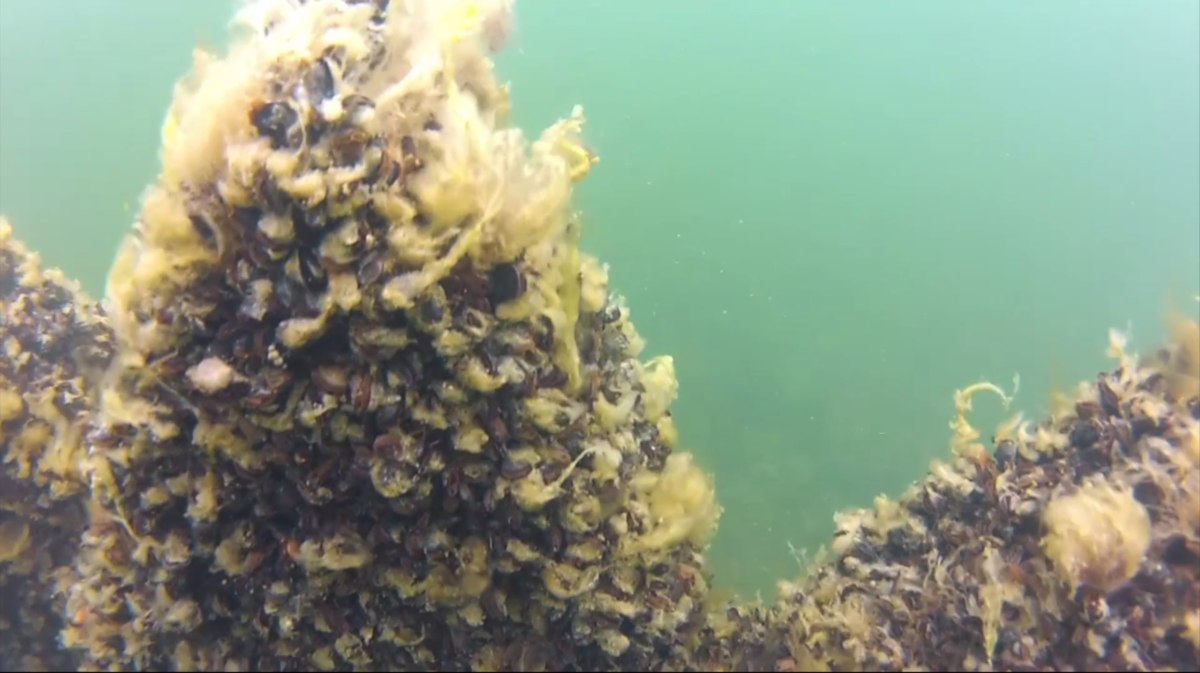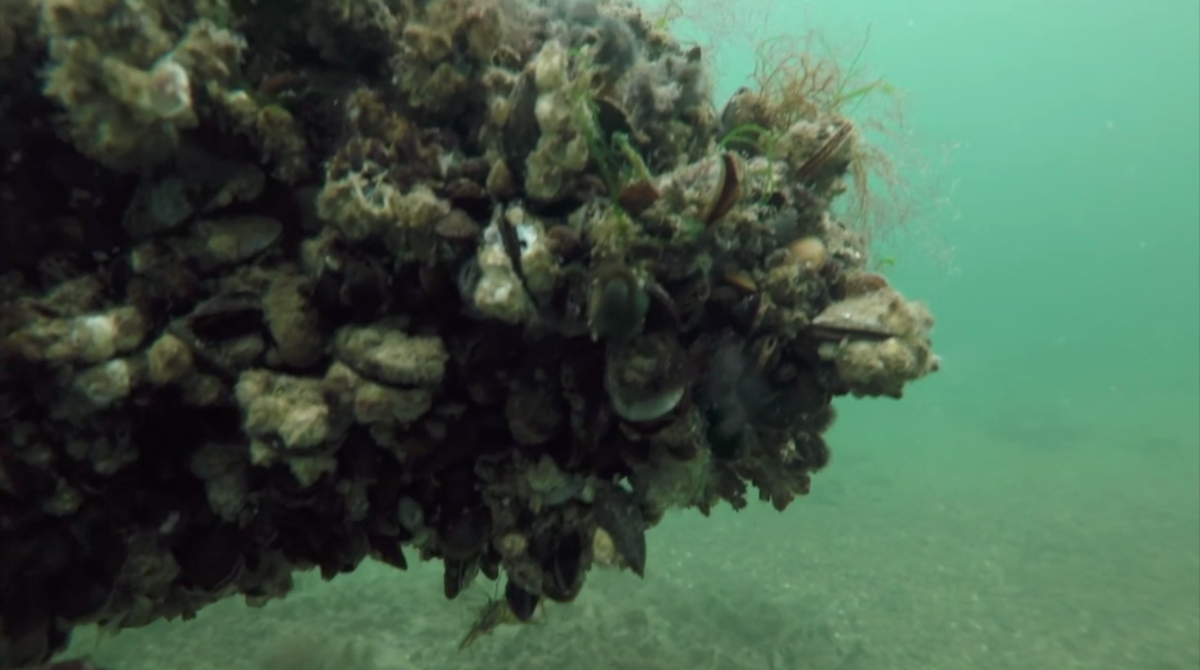Life at the Fishnest
Over a decade ago, the sculpture Fishnest was installed on the seabed in the Archipelago Sea Nature Reserve. Today, the work is home to a diverse underwater community.
In 2021, CAA invited artist Armi Nurminen to revisit the sculpture and edit a new video – titled Life at the Fishnest – using footage filmed over the years by marine conservation biologists working with Metsähallitus. The marine conversation biologists collaborated with Nurminen during the realisation of Fishnest and continue to take care of the sculpture which resides close to the island of Dalskär.
Watch Life at the Fishnest on Vimeo.
In conjunction with the making of Life at the Fishnest, marine conservation biologist Heidi Arponen shares her insights on the marine life evolving around artwork – a sculpture which has become an artificial reef and provides shelter to many species in the changing brackish water ecosystem (original Finnish text below).
“Fishnest stands majestically on the seabed and has received many visitors, according to the guest book. The sculpture is doing well and it is covered by a thick layer of blue mussels (Mytilus trossulus), bay barnacles (Amphibalanus improvisus), and sea mats (Einhornia crustulenta). Depending on the season, different filamentous algae such as sea felt (Pylaiella littoralis), brown (Ectocarpus siliculosus), red (Ceramium tenuicorne), and green algae (Cladophora glomerata) can be found. Bladderwrack is also finally spreading from the kelp zone by the rocky shore and it can occasionally be found growing on top of the structure.
The sculpture is now a living reef, giving shelter to a thriving community of diverse crustaceans such as isopods, amphipods and shrimps. As the name suggests, fish also flourish here: almost immediately after its installation, sand gobies (Pomatoschistus minutus) made nests under the sculpture’s base, and other small fish also shoal under cover of its arches. Perch (Perca fluviatilis) swim amongst the claspingleaf pondweed (Potamogeton perfoliatus) that grows around the artwork. As in previous visits, both broad-nose (Syngnathus typhle) and straightnose pipefish (Nerophis ophidion) were again seen stretching their elongated bodies on the arches of the sculpture. We have also often seen fourhorn sculpins (Myoxocephalus quadricornis) and long-spined bullheads (Taurulus bubalis) lazing next to or even on top of the installation.
Changes in the state of the Baltic Sea are visible at Fishnest. An increase in nutrients favours the growth of filamentous algae, and in midsummer, the sculpture is covered by a thick blanket of algae. Although the artwork is located on a relatively open shore where water flows well, organic matter has built up on the sculpture and the mussels that cover it. Alien species have also found Fishnest. These include rockpool shrimp (Palaemon elegans) with yellow and blue legs, which are now permanent residents. Yesterday, we also noticed Harris mud crabs (Rhithropanopeus harrisii). If Conrad’s false mussel (Mytilopsis leucophaeata) ever settles in the Archipelago Sea, we can expect to find it on the sculpture’s surface, nestled amongst the blue mussels.”
Marine conservation biologist Heidi Arponen 13.11.2021
“Siellä se edelleen majesteetillisena seisoo pohjalla, ja kävijöitäkin on vieraskirjan mukaan ollut mukavan runsaasti. Kalakodolla on kaikki kunnossa, sitä peittää runsas kerros sinisimpukoita, merirokkoja, levärupea. Näiden päällä sitten sesongin mukaan erilaisia rihmamaisia levälajeja, kuten lettiruskohahtua, litupilvilevää, punahelmilevää ja viherahdinpartaa. Rakkohaurukin on vihdoin lähtenyt leviämään rannan haurupensaikoista, sitä tavataan aina silloin tällöin Kalakodonkin päällä kasvamassa.
Veistos on todellinen elävä riutta, sen suojissa porhaltelee mm. erilaisia siiroja, katkoja ja katkarapuja. Nimensä mukaisesti sen suojissa viihtyvät kalat: hietatokot tekivät pesiään saman tien patsaan jalustan alle, ja muitakin pikkukaloja parveilee siellä kierteiden suojissa. Ahvenia pyörii veistoksen ympärillä kasvavien ahvenvitojen seassa ja tälläkin kertaa veistoksen kaarilla ojentelivat särmä- ja siloneulat pitkulaisia kylkiään. Härkä- ja piikkisimppujakin olemme monesti nähneet sekä merenpohjalla veistoksen vieressä että ihan kaarien päällä möllöttämässä.
Meren tilan muutokset näkyvät Kalakodossakin. Lisääntyvä ravinteisuus suosii rihmamaisten levien kasvua, ja keskikesällä veistoksen pintaa peittää tuuhea leväkasvillisuus. Huolimatta siitä, että veistos sijaitsee varsin avoimella rannalla, missä vesi vaihtuu hyvin, kertyy orgaanista ainesta myös patsaan ja sinisimpukoiden päälle. Vieraslajitkin ovat Kalakodon löytäneet, sirokatkaravut sinikeltaisine säärineen ovat vakiasukkaita ja eilen havaitsimme myös liejutaskurapuja. Mikäli valesinisimpukka joskus saa kunnolla jalansijaa Saaristomerellä, senkin voi tulevaisuudessa odottaa löytävän kodin Kalakodon pinnasta, sinisimpukoiden seasta.”
Meribiologi, suojelubiologi Heidi Arponen 13.11.2021
The video Life at the Fishnest has been produced as part of a series of events – titled Ecology of Change – which revisits the site-specific artworks commissioned for the exhibition Contemporary Art Archipelago (part of the Turku 2011 European Capital of Culture programme). It is supported by the Swedish Cultural Foundation in Finland.






